Data access
Presentation
The LSCE, one of the POSTEL Expertise Centre, defined a new method to select the BRDFs from POLDER-3/PARASOL data acquired from November 2005 to October 2006 in order to build 4 BRDF databases :
- 2 MONTHLY databases gathering the best quality BRDFs for each month, independently : one based upon the IGBP land cover map, the second based upon the GLC2000 land cover map
- 2 YEARLY databases designed to monitor the annual cycle of surface reflectance and its directional signature. The selection of high quality pixels is based on the full year. The first database is based upon the IGBP land cover map, the second one is based upon the GLC2000 land cover map.
The methodology relies on 3 main steps :
- the selection of thematically-homogeneous pixels, according to the land cover map (IGBP or GLC2000)
- a pre-selection of a fixed number of pixels according to the quality of the inversion of a reflectance model against one month of data. This criterium allows removing the noisiest BRDFs and those with few observations.
- the final selection of the best BRDFs. In this last step, the selection accounts for the quality of the reflectance model inversion over one single orbit, which allows removing the noisy orbits that could disturb the overall quality of the BRDF.
The steps 2 and 3 are applied to reflectances measured at 670nm, which allow selecting BRDFs generally clean at all wavebands.
At final, we got :
- a MONTHLY database wich contains 20,985 BRDFs shared in the 22 GLC2000 classes
- a YEARLY database which contains 20,907 BRDFs shared in the 22 GLC2000 classes
- a MONTHLY database which contains 13,879 BRDFs shared in the 16 IGBP classes
- a YEARLY database which contains 13,166 BRDFs shared in the 16 IGBP classes
These databases contain also the Bidirectional Polarized reflectance Distribution Function (BPDF) measured at 865nm for each selected pixel.
Comparing to the existing POLDER-1 and POLDER-2 BRDF databases, the POLDER-3/PARASOL databases present many improvements. The criteria of selection, now relying on the quality of a model inversion, favours the smoothest BRDFs. One year of acquisitions allow monitoring the variations of BRDF over a full vegetative cycle. The orbital cycle of PARASOL, longer than the ADEOS-2 one, provides a better angular sampling of the BRDF. Observations under larger viewing angles (up to 60°) give the opportunity to investigate the ability of models to simulate the BRDF sides.
In any publication using the POLDER-3/PARASOL BRDF databases, please include the following quotation : « The POLDER-3/PARASOL BRDFs databases have been elaborated by the LSCE, and provided by the POSTEL Service Centre. The POLDER-3/PARASOL data are from Cnes. »
The multi-temporal BRDFs of the YEARLY databases (example below) allows monitoring the evolution of the reflectances (%) magnitude and of the BRDF shape according to the vegetation cycle and the changes of the surface properties. One potential use of such information is the set-up of standard BRDFs (Bacour and Bréon, 2005) useful to perform correction of directional effects in AVHRR reflectance time series (Bacour et al., 2006).
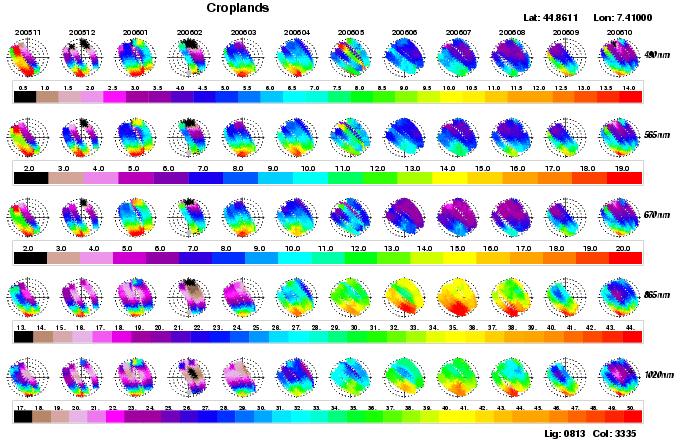
BRDFs of a crop area located in the Pô valley (Italy) as measured by POLDER-3/PARASOL over one year
The MONTHLY databases provides the best BRDFs for each month. The graphs below show the bi-directional reflectances (%) at 670 nm (left) and 865 nm (right) in the angular space for various ecosystems at different period of the year. The major features of the BRDF are a peak of reflectance when the sun and the viewing directions coincide (the hot spot effect) and a minimum of reflectance in the forward scattering direction. These patterns are clearly displayed on the data collected in the principal plane. The BRDF of snow displays well distinct spectral profiles, with reflectances at 670nm larger than near-infrared reflectances. The specific bowl shape shows an increase of reflectance in the forward direction, which translates the presence of a thin water layer at the surface.
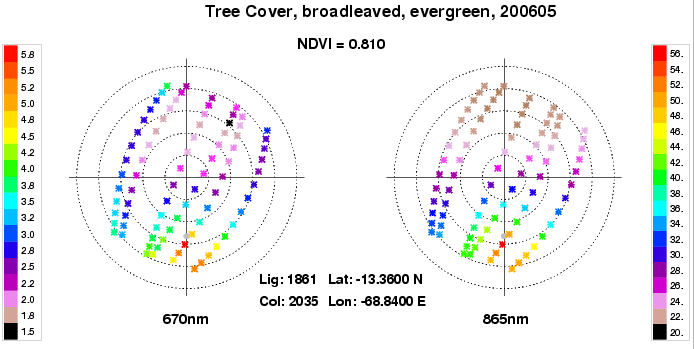
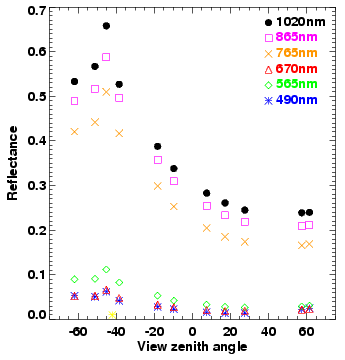
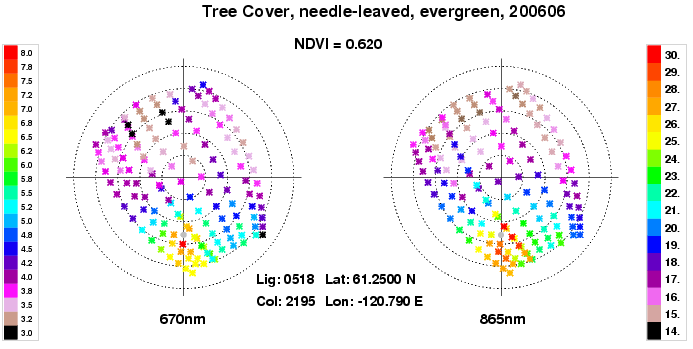
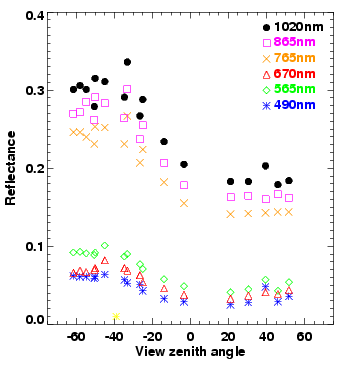
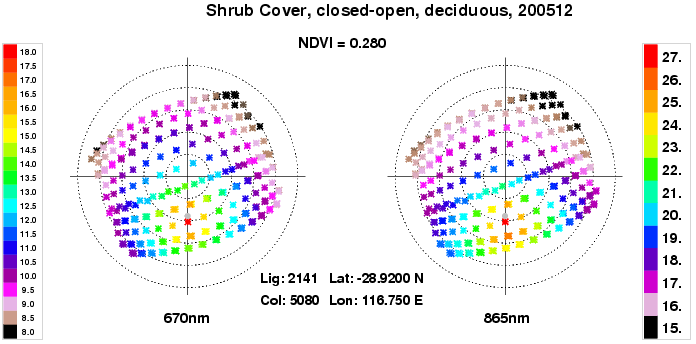
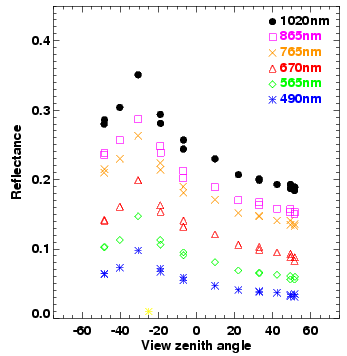
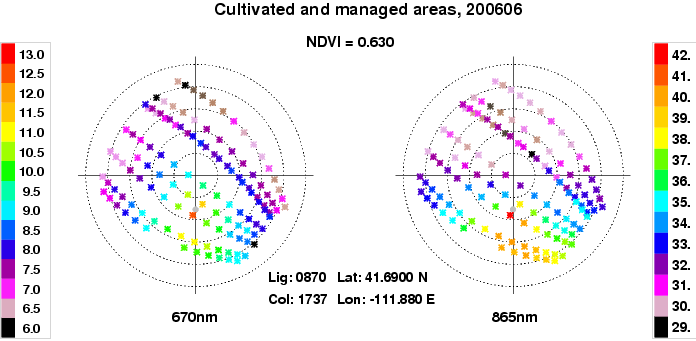
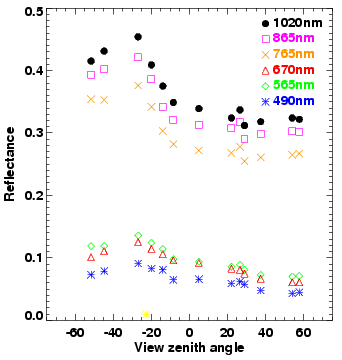
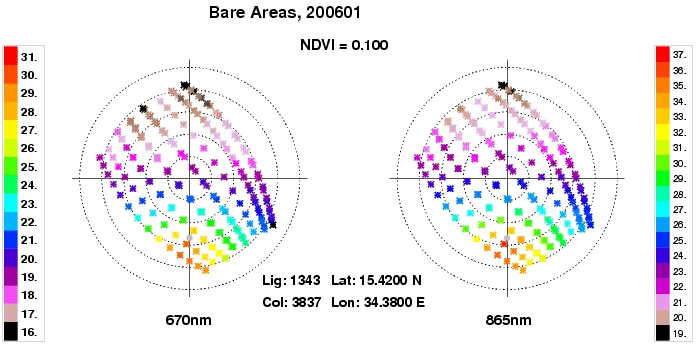
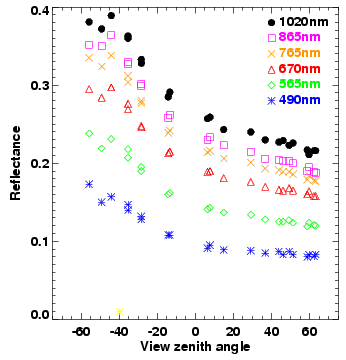
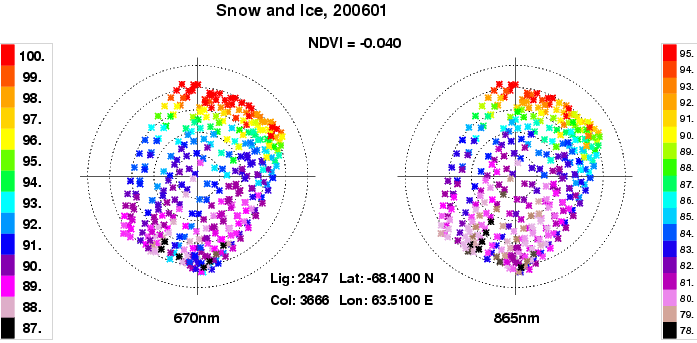
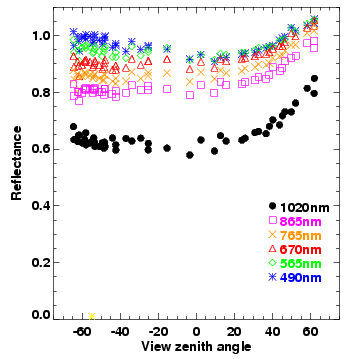
The shape of BPDF is similar for all surface types (examples below) : at a given sun angle, the polarized reflectance increases from the backscattering directions to the forward scattering directions. The minimum around the backscattering direction is due to the fact that polarization is mostly generated by specular reflection. For given angular conditions, the magnitude of polarized reflectance is higher over bare soil than over vegetated areas. When polarizing elements are present on the pixel, like water ponds, a strong « glitter » effect is displayed in the specular direction. Nadal and Bréon (1999) have used the polarized reflectances measured by POLDER-1 to generate empirical surface BPDFs of eleven surface types defined by the IGBP classification and the NDVI. These BPDFs are used, for example, to correct the TOA polarized reflectance measurements for an estimate of aerosol characteristics over land surfaces. This methodology is part of atmospheric correction algorithm applied in the operational Land Surface processing line to carry out the tropospheric aerosol correction on POLDER-3/PARASOL data for retrieving the surface reflectance.
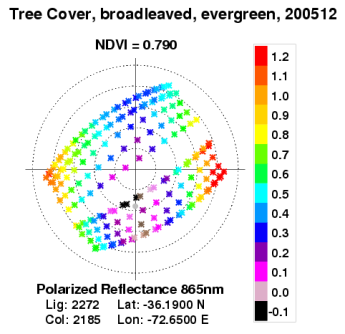
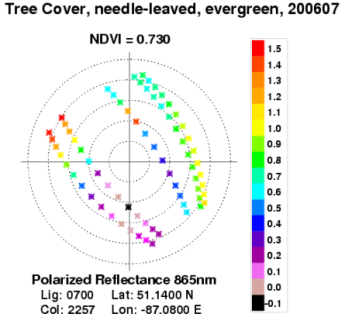
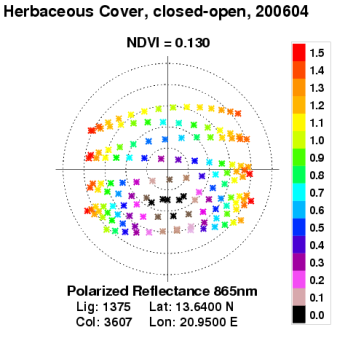
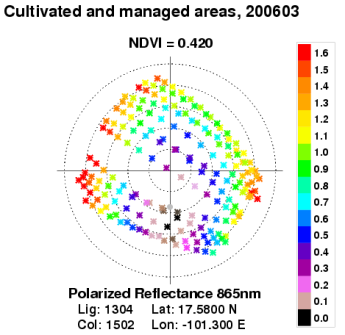
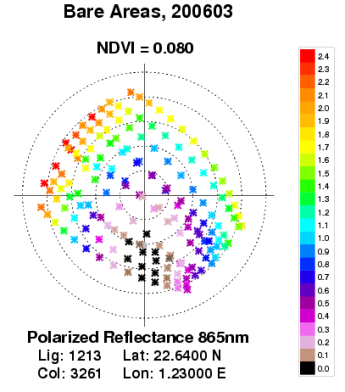
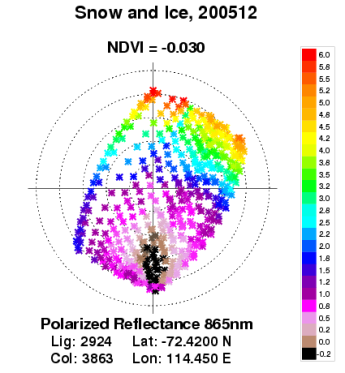
Format
A user manual details the algorithm, analyses the databases, and describes the file format..
The Visu_BRDF_PARASOL software, developed by LSCE, allows visualizing the BRDF data bases, testing 6 BRDF models, linear or non-linear, and comparing the results of model inversion with the measurements.
References
Bacour, C. and F.M. Bréon, Variability of biome reflectance directional signature as seen by POLDER, Remote Sensing of Environment, 98, 80-95, 2005. Bacour and Bréon, RSE, 2005
Bacour, C., FM. Bréon, and F. Maignan, Normalisation of the directional effect on NOAA-AVHRR reflectances measurements for an improved monitoring of vegetation cycles, Remote Sensing of Environment, 102, 402-413, 2006. Bacour et al., RSE, 2006 {PDF}
Bréon, F.M., E. Fédèle, F. Maignan, and R. Lacaze, A database of directional reflectance signature (GLC2000) with an analysis tool, A-Train Symposium, Lille, 22-25 October 2007 Poster BRDF PARASOL GLC2000 {PDF}
Bréon, F.M., E. Fédèle, F. Maignan, and R. Lacaze, A database of directional reflectance signature (IGBP) with an analysis tool, A-Train Symposium, Lille, 22-25 October 2007 Poster BRDF PARASOL IGBP {PDF}
Nadal, F. et F.M. Bréon, Parametrization of surface polarized reflectance derived ffrom POLDER spaceborne measurements, IEEE Transactions on Geoscience and Remote Sensing, 37, 1709-1718, 1999.

